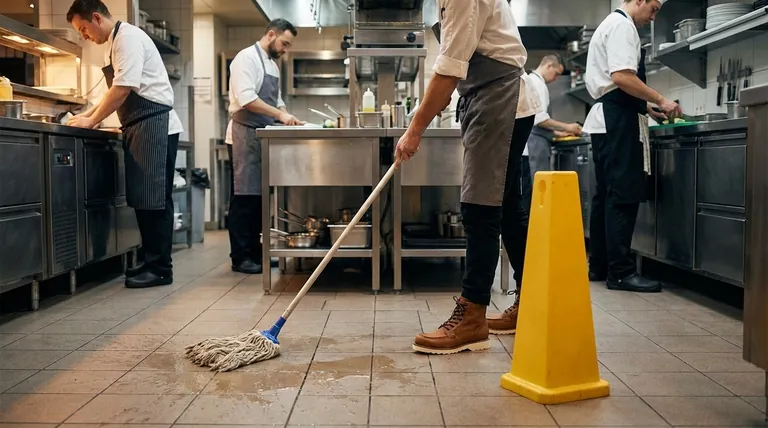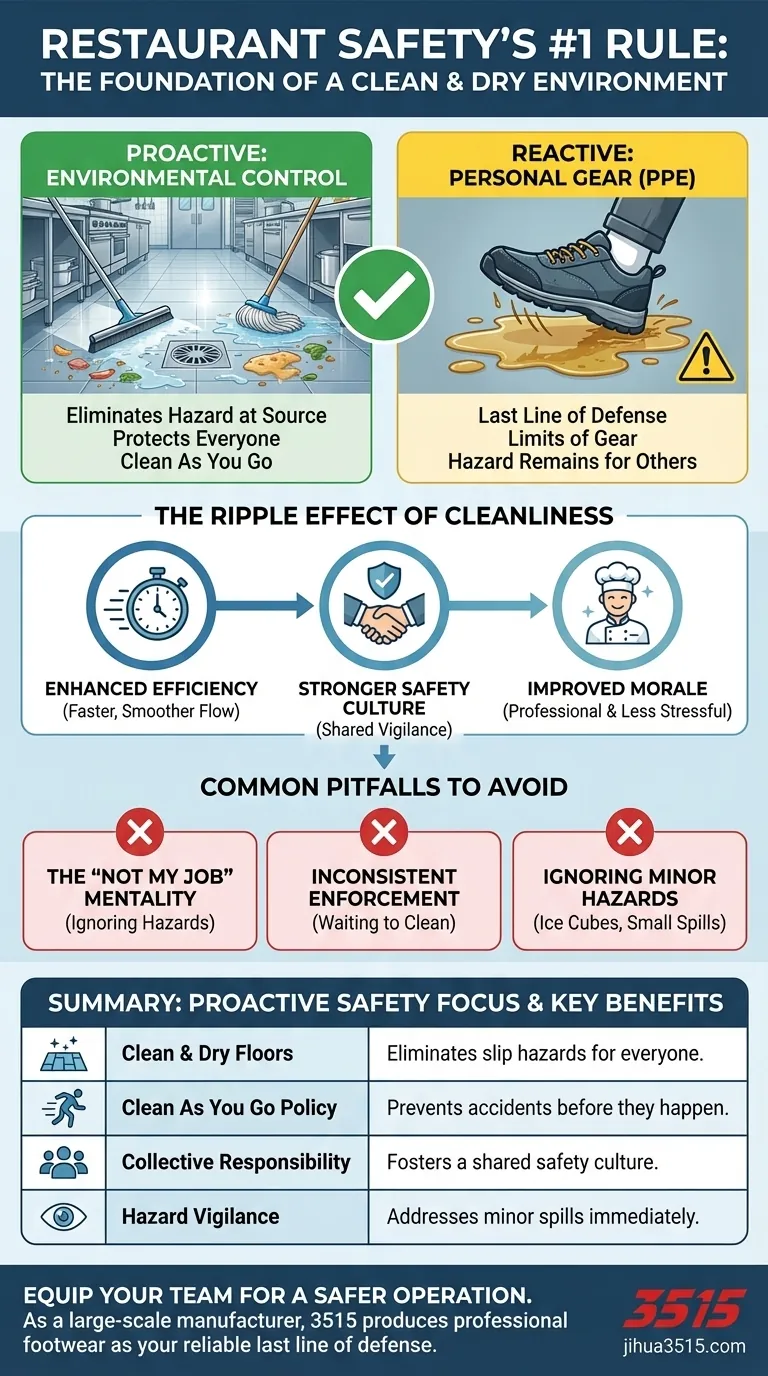Beyond personal gear like non-slip shoes, the single most critical tip for maintaining restaurant safety is to ensure a consistently clean and dry work environment. Regularly removing hazards like water, oil, and food debris from floors is the most effective way to prevent accidents before they happen.
The state of your floors is a direct indicator of your overall safety culture. While equipment like non-slip shoes is a reactive defense, proactive environmental control—keeping floors free of hazards—is the true foundation of preventing accidents.

Why Environmental Control Outweighs Equipment Alone
Relying solely on personal protective equipment (PPE) is a fundamentally reactive strategy. True safety comes from proactively eliminating the hazard at its source.
The Limits of Protective Gear
Even the best slip-resistant footwear can fail. A large grease spill or a significant amount of water can overwhelm the tread on any shoe, rendering it ineffective.
Non-slip shoes are your last line of defense, not your first. They are designed to mitigate the risk of a slip, not to make you immune to hazardous conditions.
A Proactive vs. Reactive Approach
Cleaning a spill immediately removes the hazard from the environment. This is a proactive measure that protects everyone, regardless of their footwear.
Wearing non-slip shoes is a reactive measure that only helps an individual cope with an existing hazard. The danger still remains for others until it is cleaned.
Hazards Are More Than Just Spills
The concept of a clean environment extends beyond visible liquids. Small pieces of food, dropped ice, loose debris like small rocks tracked in from outside, or even excess dust can act like ball bearings under a shoe, causing a slip.
The Ripple Effect of a Clean Environment
Prioritizing a clean workspace creates cascading benefits that extend far beyond preventing falls. It is the cornerstone of a well-run and safe operation.
Enhancing Operational Efficiency
A clean and clear floor allows staff to move quickly, confidently, and without hesitation. There are no obstacles to navigate, which reduces mental load and speeds up service, especially during peak hours.
Fostering a Culture of Safety
When management and team leaders visibly prioritize keeping the environment free of hazards, it sends a powerful message. It demonstrates that safety is a shared, constant responsibility, not just an item on a checklist.
Improving Morale and Professionalism
Working in a clean, organized space is less stressful and more professional. It shows respect for the staff and the work they do, which can lead to higher morale and greater attention to detail in all tasks.
Common Pitfalls in Environmental Safety
Simply having a policy is not enough. Execution is everything, and several common mindsets can undermine even the best intentions.
The "It's Not My Job" Mentality
The most dangerous pitfall is when staff believe cleaning is someone else's responsibility. Safety must be a collective duty where the person who sees the hazard is the person who deals with it immediately.
Inconsistent Enforcement
Cleaning schedules are important, but the most critical rule is "clean as you go." Waiting until the end of a shift to address a spill that happened hours earlier creates an unnecessary window of high risk.
Ignoring Minor Hazards
It is easy to walk past a single dropped ice cube or a small splash of water. However, these minor issues are the most frequent causes of serious accidents. A culture of vigilance means treating every hazard as a priority.
Making the Right Choice for Your Goal
To translate this principle into action, tailor your approach to your team's primary objective.
- If your primary focus is immediate risk reduction: Implement a non-negotiable "clean as you go" policy where every team member is empowered and required to address spills instantly.
- If your primary focus is building a safety culture: Start each shift by assigning a rotating "safety spotter" whose secondary role is to actively monitor floor conditions and call out hazards.
- If your primary focus is operational excellence: Integrate specific cleaning and clearing tasks directly into your workflow checklists for both front and back of house.
Ultimately, a safe restaurant is not built on the equipment people wear, but on the disciplined, consistent habits of the entire team.
Summary Table:
| Proactive Safety Focus | Key Benefit |
|---|---|
| Clean & Dry Floors | Eliminates slip hazards at the source for everyone. |
| 'Clean As You Go' Policy | Prevents accidents before they happen. |
| Collective Responsibility | Fosters a strong, shared safety culture. |
| Hazard Vigilance | Addresses minor spills and debris immediately. |
Equip your team for a safer, more efficient operation.
As a large-scale manufacturer, 3515 produces a comprehensive range of professional footwear, including non-slip shoes and boots for restaurant staff. Our products are designed to be the reliable last line of defense in a proactive safety strategy.
We partner with distributors, brand owners, and bulk clients to supply durable footwear that supports the safety culture you build. Let us help you protect your team.
Contact us today to discuss your footwear needs and enhance your restaurant's safety.
Visual Guide

Related Products
- Durable Leather Moc Toe Work Boots for Wholesale & Custom Manufacturing
- Durable Moc-Toe Wedge Work Boots | Wholesale Manufacturing for Brands
- Customizable Slip-On Safety Shoes Direct from the Factory for Wholesale
- Safety Footwear Wholesale Manufacturer for Custom OEM/ODM Production
- Wholesale Anti-Smash & Puncture-Proof Safety Shoes Custom Manufacturing for Brands
People Also Ask
- Why is it important to choose the right work boots for your job? Ensure Safety, Comfort, and Performance
- What is the average lifespan of work boots? Extend Your Boots' Life with Expert Care
- Why is it important to take care of your feet? Secure Your Mobility and Overall Health
- Why are slip-on moc toe shoes a practical choice for formal events? Unlock Effortless Style & Comfort
- What are some reported advantages of this work boot from user reviews? A Durable Investment for Demanding Jobs
















